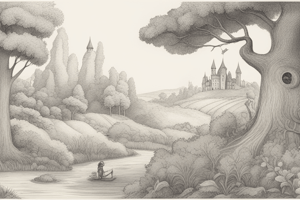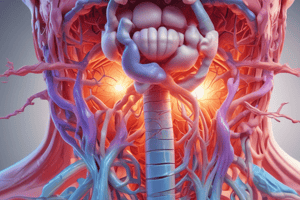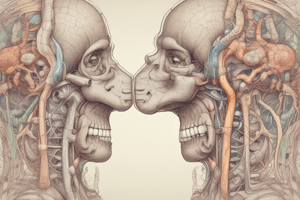Podcast
Questions and Answers
What is the primary function of the human respiratory system?
What is the primary function of the human respiratory system?
- To produce carbon dioxide
- To absorb nutrients from the air
- To facilitate the exchange of gases (correct)
- To filter toxins from the bloodstream
What happens to brain cells after five minutes without oxygen?
What happens to brain cells after five minutes without oxygen?
- They continue functioning normally
- They begin to die (correct)
- They completely regenerate
- They become more active
How do the lungs supply oxygen to the body's cells?
How do the lungs supply oxygen to the body's cells?
- Through chemical reactions
- By releasing oxygen directly into the bloodstream
- By converting carbon dioxide into oxygen
- Via the blood and cardiovascular system (correct)
Which of the following is NOT a primary organ of the human respiratory system?
Which of the following is NOT a primary organ of the human respiratory system?
What gas do humans need to sustain life?
What gas do humans need to sustain life?
Which process occurs when we breathe in?
Which process occurs when we breathe in?
Why is the rapid supply of oxygen crucial for human life?
Why is the rapid supply of oxygen crucial for human life?
What can occur if the brain is deprived of oxygen for too long?
What can occur if the brain is deprived of oxygen for too long?
Which of the following best describes the primary function of the respiratory system in frogs?
Which of the following best describes the primary function of the respiratory system in frogs?
What is a unique feature of the frog's respiratory structures compared to humans?
What is a unique feature of the frog's respiratory structures compared to humans?
Which of the following organs is primarily involved in respiration for frogs?
Which of the following organs is primarily involved in respiration for frogs?
How do humans primarily breathe compared to frogs?
How do humans primarily breathe compared to frogs?
Which taxonomic group does not primarily use lungs for respiration?
Which taxonomic group does not primarily use lungs for respiration?
In what way does the pathway of respiration differ in frogs as compared to humans?
In what way does the pathway of respiration differ in frogs as compared to humans?
What is the primary pathway of air during human respiration?
What is the primary pathway of air during human respiration?
Which respiratory structure is NOT found in frogs?
Which respiratory structure is NOT found in frogs?
What is exchanged during the process of respiration?
What is exchanged during the process of respiration?
Where does external respiration occur?
Where does external respiration occur?
What is the role of carbon dioxide in respiration?
What is the role of carbon dioxide in respiration?
What is the respiratory zone responsible for?
What is the respiratory zone responsible for?
Which of the following best describes internal respiration?
Which of the following best describes internal respiration?
How does carbon dioxide move from cells to the lungs?
How does carbon dioxide move from cells to the lungs?
What are the two zones of the respiratory system?
What are the two zones of the respiratory system?
During respiration, what happens to oxygen in the cells?
During respiration, what happens to oxygen in the cells?
Which of the following sources is NOT listed as a reference for the module?
Which of the following sources is NOT listed as a reference for the module?
What is the main type of respiratory system discussed in the module?
What is the main type of respiratory system discussed in the module?
Which of the following actions is part of the self-regulated assessment task?
Which of the following actions is part of the self-regulated assessment task?
What kind of information can be found in the provided electronic sources?
What kind of information can be found in the provided electronic sources?
Which book focuses specifically on invertebrate functions and structures?
Which book focuses specifically on invertebrate functions and structures?
What is the primary function of suction in respiratory processes?
What is the primary function of suction in respiratory processes?
Which statement accurately describes the gular pump mechanism?
Which statement accurately describes the gular pump mechanism?
Buccal pumping is primarily identified as which of the following?
Buccal pumping is primarily identified as which of the following?
In which group of animals is buccal pumping the sole means of inflating the lungs?
In which group of animals is buccal pumping the sole means of inflating the lungs?
What is the role of aspiration in the respiratory process?
What is the role of aspiration in the respiratory process?
Which of the following correctly describes how air is pumped by the gular pump?
Which of the following correctly describes how air is pumped by the gular pump?
Which characteristic is unique to buccal pumping compared to other breathing methods?
Which characteristic is unique to buccal pumping compared to other breathing methods?
Which animal group is most likely to utilize the gular pump for breathing?
Which animal group is most likely to utilize the gular pump for breathing?
What is a common characteristic of suction as a breathing method?
What is a common characteristic of suction as a breathing method?
The rhythmic movement in buccal pumping aids in which of the following?
The rhythmic movement in buccal pumping aids in which of the following?
Study Notes
Respiratory System
- The human respiratory system's primary function is gas exchange, taking in oxygen and expelling carbon dioxide.
- The respiratory system is composed of the lungs, which are responsible for gas exchange during breathing.
- The human respiratory system is made up of a conduction zone and a respiratory zone.
- The respiratory zone is found deep inside the lungs and is responsible for gas exchange.
- The respiratory system is essential for life. Without oxygen, brain cells begin dying after only five minutes, leading to brain damage and death.
- Oxygen is transported from the lungs to the heart, and then pumped to the cells via the cardiovascular system. The cells use oxygen to obtain energy and release carbon dioxide as waste.
- The exchange of gases occurs in the lungs (external respiration) and in the cells (internal respiration).
Frog Respiratory System
- Frogs use a combination of lung and skin respiration for gas exchange.
- The frog's respiratory system includes lungs, skin, and mouth/throat.
- The frog's lungs are simple sacs with a small surface area compared to human lungs.
- Frogs can breathe through their skin, which is moist and permeable to gases.
- Frogs also use their mouth/throat as a pump to force air into their lungs, and expel it using a combination of pressure changes.
- Frogs use a gular pump to increase the volume of their throat, drawing air into the lungs, and then closing the glottis and forcing air out of the lungs.
- Frogs can also use a buccal pump, expanding and contracting the floor of their mouth to pump air into their lungs.
- The buccal pump is the primary method of inflating the lungs in amphibians.
Differences between Human and Frog Respiration
- Humans primarily breathe through their lungs, with a complex system of airways and alveoli designed for efficient gas exchange.
- Frogs can breathe through their skin, mouth/throat, and lungs, but their lungs are not as developed as human lungs.
- Humans use a diaphragm and intercostal muscles to expand the lungs, while frogs rely on pressure changes in their mouth/throat to force air into their lungs.
- Human breathing is controlled by the nervous system, while frog breathing is more instinctual and often relies on their environment.
Assessment
- Students are assessed on the material through assigned tasks in Google Classroom.
- References, including books and electronic sources, are provided for further study.
- Students are encouraged to complete the module to prepare for the next module.
Studying That Suits You
Use AI to generate personalized quizzes and flashcards to suit your learning preferences.
Related Documents
Description
This quiz explores the fundamental aspects of the human and frog respiratory systems. It covers the structures involved in gas exchange, the importance of oxygen, and the unique respiratory methods of frogs. Test your knowledge on how different organisms adapt to their respiratory needs.





